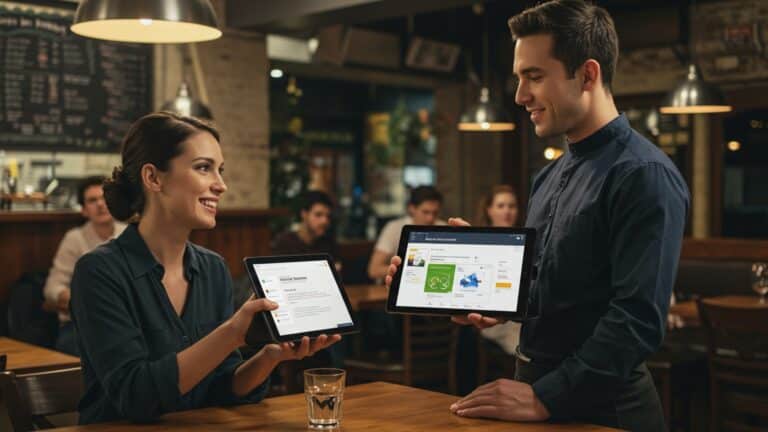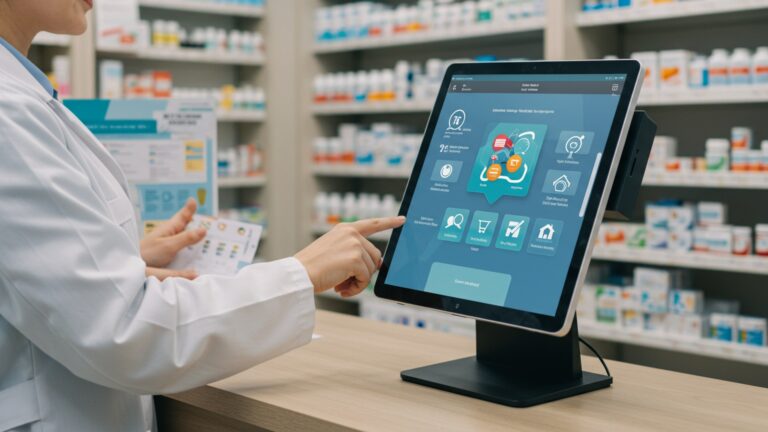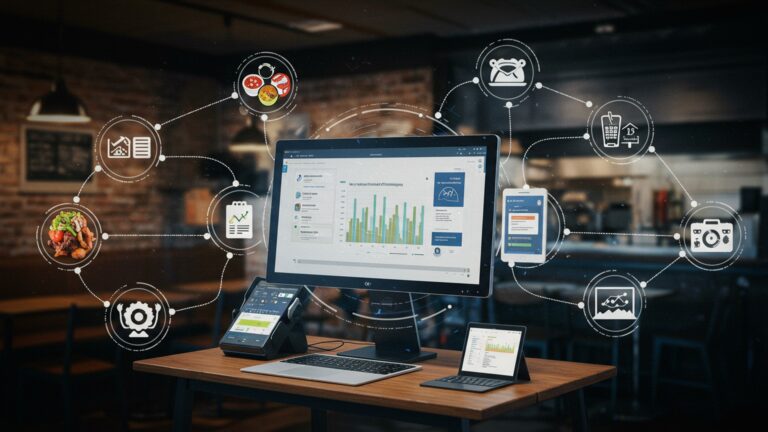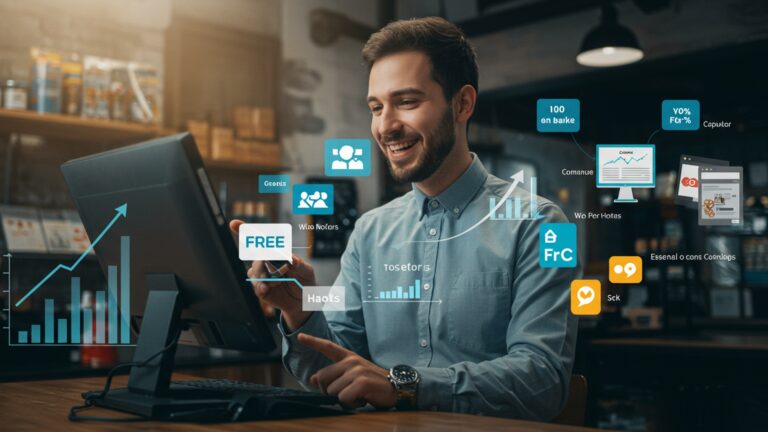Mastering Restaurant Operations 10 Features Your POS Software Must Have
The modern restaurant landscape demands more than just basic transaction processing; it requires a sophisticated operational command center to thrive amidst evolving challenges like dynamic supply chains and surging digital orders. Forward-thinking restaurateurs now recognize that effective restaurant POS software extends far beyond simple order entry, acting as the central nervous system for their entire business. Leading systems integrate real-time inventory management, predictive sales analytics. seamless third-party delivery platform connectivity, transforming raw data into actionable insights. This strategic pivot empowers businesses to optimize labor costs, enhance customer experiences through personalized service. maintain agility, moving beyond reactive management to proactive, data-driven decision-making essential for sustained profitability.
Understanding Restaurant POS Software: The Backbone of Modern Eateries
In today’s fast-paced culinary world, efficiency and precision are paramount. At the heart of a successful restaurant operation lies a powerful tool: the Restaurant POS (Point of Sale) software. Far more than just a cash register, modern Restaurant POS software is an integrated system designed to streamline every aspect of a restaurant’s daily activities, from taking orders to managing inventory and analyzing sales data. It’s the central nervous system that connects the front-of-house (FOH) with the back-of-house (BOH), ensuring smooth communication and optimal customer experience.
Essentially, a POS system processes transactions. specialized Restaurant POS software goes deeper, offering features tailored specifically to the unique demands of food service. This includes handling complex order modifications, managing tables, tracking ingredients. even integrating with online ordering platforms. Think of it as your command center, providing real-time insights and automating tasks that would otherwise consume valuable staff time.
1. Seamless Order Management and Customization
The core function of any Restaurant POS software is efficient order processing. This feature goes beyond simply ringing up items; it empowers staff to take orders quickly and accurately, even during peak rush hours. A robust system allows for extensive customization, catering to every customer’s unique request.
- Intuitive Order Entry
- Modifier Management
- Split Checks & Transfers
- Kitchen Display Systems (KDS) Integration
Servers can input orders with just a few taps, reducing errors and speeding up service. Many systems feature visual menus that mirror your physical menu, making navigation simple.
This is crucial for restaurants. Customers often request “no onions,” “extra cheese,” or “sauce on the side.” Advanced Restaurant POS software allows for easy addition, removal, or modification of ingredients and preparation instructions, sending clear messages directly to the kitchen.
Facilitating group dining, the software should effortlessly split bills by item or evenly. transfer orders between tables or servers without hassle.
A modern KDS replaces paper tickets, displaying orders digitally in the kitchen. This dramatically improves communication, reduces errors. helps kitchen staff prioritize and manage cooking times effectively. For example, a KDS can highlight urgent orders or alert staff when a dish has been waiting too long, ensuring food quality and timely delivery.
Imagine a busy Friday night. A table of six makes several special requests and wants to split the bill three ways. With a feature-rich Restaurant POS software, a server can handle this complex order in minutes, sending precise instructions to the kitchen and presenting accurate, split bills without manual calculations or confusion.
2. Comprehensive Inventory Management
For restaurants, managing inventory is a delicate balance. Too much stock leads to spoilage and waste; too little means running out of popular dishes. Excellent Restaurant POS software provides the tools to maintain this balance, directly impacting your bottom line.
- Real-time Tracking
- Recipe Management
- Supplier Management & Ordering
- Waste & Spoilage Tracking
Automatically deducts ingredients from inventory as dishes are sold. This provides an accurate, up-to-the-minute view of stock levels for every item, from olive oil to prime cuts of beef.
Input your recipes into the system. the Restaurant POS software can automatically calculate ingredient usage per dish, improving portion control and costing.
Maintain a database of suppliers, track delivery schedules. even generate purchase orders directly from the system based on low stock alerts. Some advanced systems can integrate directly with supplier catalogs.
Record discarded items or spoiled ingredients to get a true picture of food costs and identify areas for improvement. This data is invaluable for reducing unnecessary expenses.
By leveraging this feature, a restaurant can significantly reduce food waste, optimize ordering quantities. prevent the frustrating scenario of telling a customer their favorite dish is unavailable.
3. Efficient Table Management and Reservations
Optimizing seating arrangements and managing bookings are crucial for maximizing restaurant capacity and ensuring a smooth guest experience. This is where Restaurant POS software truly shines, offering features to handle the flow of customers effectively.
- Visual Table Layout
- Reservation System Integration
- Waitlist Management
- Guest History
A graphical representation of your restaurant’s floor plan allows staff to see which tables are occupied, available, or soon-to-be-vacant in real-time. This helps hosts make quick, informed seating decisions.
Seamlessly integrate with online reservation platforms (e. g. , OpenTable, Resy) or offer an in-house booking system. This feature helps manage waitlists, predict busy periods. allocate tables efficiently.
For walk-ins during peak times, a digital waitlist allows staff to quote accurate wait times, send SMS notifications to guests when their table is ready. optimize table turnover.
Tie reservations to customer profiles, allowing staff to note preferences (e. g. , “prefers window seat,” “allergic to nuts”) for a personalized dining experience on return visits.
A popular bistro often had long queues. Implementing Restaurant POS software with integrated table and waitlist management allowed them to reduce average wait times by 15% and increase table turns by 10% during peak hours, significantly boosting revenue and customer satisfaction.
4. Robust Customer Relationship Management (CRM) & Loyalty Programs
Building a loyal customer base is vital for long-term success. Modern Restaurant POS software includes CRM capabilities to help foster these relationships and drive repeat business.
- Customer Databases
- Loyalty Programs
- Targeted Marketing
- Feedback Collection
Collect and store customer data, including contact details, order history. preferences (e. g. , favorite dishes, dietary restrictions). This data is invaluable for personalized marketing.
Easily set up and manage loyalty programs, such as points-based rewards, tiered memberships, or punch cards. Customers can earn rewards directly through their purchases, encouraging them to return.
Use collected data to send personalized promotions, birthday offers, or exclusive discounts to specific customer segments. For instance, if a customer frequently orders vegetarian dishes, you can send them promotions for new vegetarian menu items.
Some Restaurant POS software can integrate with feedback tools, allowing customers to provide reviews directly, which helps identify areas for improvement.
“In today’s competitive restaurant landscape, understanding your customers is just as essential as the food you serve,” notes a leading hospitality consultant. “A good Restaurant POS software provides the data to turn casual diners into loyal patrons.”
5. Detailed Reporting and Analytics
Data is power. a comprehensive Restaurant POS software transforms raw transaction data into actionable insights. This feature is crucial for making informed business decisions, identifying trends. optimizing operations.
- Sales Reports
- Labor Reports
- Inventory Reports
- Customer Reports
- Customizable Dashboards
Generate reports on daily, weekly, monthly. yearly sales. Breakdowns by menu item, category, time of day. payment method reveal what’s selling best and when.
Track employee hours, sales per employee. labor costs. This helps optimize staffing levels and identify top performers.
grasp ingredient usage, identify waste. pinpoint popular or slow-moving items. This ties directly into profitability.
examine customer demographics, average spend. visit frequency to tailor marketing efforts.
Many systems offer customizable dashboards that provide a real-time overview of key performance indicators (KPIs), allowing managers to quickly assess business health.
| Report Type | Key Insight Gained | Actionable Outcome |
|---|---|---|
| Sales by Item | Best-selling dishes, slow movers | Optimize menu, identify promotional opportunities |
| Labor Cost Percentage | Staffing efficiency during peak/off-peak | Adjust schedules, manage overtime |
| Inventory Variance | Difference between theoretical and actual usage | Identify waste, theft, or portion control issues |
6. Streamlined Employee Management
Managing staff efficiently is vital for any restaurant. A feature-rich Restaurant POS software can significantly reduce administrative burden and improve workforce productivity.
- Time Clock Integration
- Shift Scheduling
- Performance Tracking
- Payroll Integration
- Role-Based Permissions
Employees can clock in and out directly through the POS terminal, ensuring accurate timekeeping. This eliminates manual punch cards and reduces payroll errors.
Some advanced systems allow managers to create and manage employee schedules within the software, distributing shifts and managing availability.
Monitor individual employee sales performance, average check size. service speed. This data can be used for training, motivation. performance reviews.
Seamlessly export time clock data to popular payroll systems, simplifying payroll processing and reducing manual data entry.
Assign different access levels to employees based on their roles (e. g. , servers can’t access financial reports, managers can). This enhances security and accountability.
“Before we upgraded our Restaurant POS software, payroll was a nightmare,” shares a restaurant owner from Brooklyn. “Now, with integrated time clocks and payroll export, what used to take me half a day is done in an hour. It’s freed up so much time to focus on our food and guests.”
7. Secure Payment Processing and Flexibility
In an era of diverse payment methods, your Restaurant POS software must handle transactions securely and efficiently. This feature is non-negotiable for customer convenience and business integrity.
- Multiple Payment Options
- PCI DSS Compliance
- Integrated vs. Standalone Processing
- Mobile Payment Solutions
- Robust Security Features
Accept various payment types including cash, credit/debit cards (EMV chip cards), contactless payments (NFC like Apple Pay, Google Pay). gift cards.
Ensure your system adheres to the Payment Card Industry Data Security Standard (PCI DSS) to protect sensitive customer payment data and minimize the risk of data breaches.
Integrated processing means your POS software directly communicates with the payment processor, speeding up transactions and reducing manual entry errors. Standalone terminals require manual entry, which is slower and prone to mistakes.
Enable pay-at-the-table options with handheld devices, improving service speed and enhancing customer experience.
Look for features like end-to-end encryption and tokenization to safeguard transaction data.
EMV stands for Europay, MasterCard. Visa. It refers to the global standard for credit and debit payment cards that are equipped with a microchip, providing enhanced security against fraud compared to traditional magnetic stripe cards. NFC (Near Field Communication) allows for contactless payments by tapping a smartphone or card near a reader.
8. Integrated Online Ordering and Delivery Management
The rise of online ordering and food delivery has transformed the restaurant industry. A modern Restaurant POS software must integrate seamlessly with these channels to capture a broader market.
- Direct Online Ordering Portal
- Third-Party Delivery Platform Integration
- Delivery Driver Management
- Menu Synchronization
Offer your customers an intuitive online ordering platform directly integrated with your POS. Orders flow directly into your kitchen display system, eliminating the need for manual re-entry.
Connect with popular delivery services (e. g. , Uber Eats, DoorDash, Grubhub). This centralizes orders from multiple sources into a single system, simplifying management and preventing missed orders.
For in-house delivery, track driver availability, assign orders. monitor delivery routes, ensuring timely service.
Easily update your online menu, prices. availability directly from your Restaurant POS software, ensuring consistency across all platforms.
By centralizing online and in-person orders, a restaurant can significantly reduce operational complexity, decrease order errors. expand its reach beyond its physical location, tapping into the lucrative delivery market.
9. Multi-Location Management Capabilities
For restaurants operating multiple branches or planning expansion, a Restaurant POS software with multi-location management is indispensable. It provides centralized control and consistency across all outlets.
- Centralized Menu Management
- Consolidated Reporting
- Centralized Inventory
- Employee Management Across Locations
- Scalability
Update menus, prices. promotions for all locations simultaneously from a single dashboard, ensuring brand consistency.
View sales, labor. inventory reports across all locations, or drill down into individual store performance. This provides a holistic view of the business.
Manage inventory and suppliers for all locations from one place, allowing for bulk purchasing advantages and efficient stock transfers between stores.
Manage employee profiles, permissions. possibly even schedules across different branches.
The system should be designed to easily add new locations as your business grows, without requiring a complete overhaul of your technology infrastructure.
Comparison: Single vs. Multi-Location POS
| Feature | Single-Location POS | Multi-Location Restaurant POS Software |
|---|---|---|
| Menu Updates | Manual update per terminal | Centralized update for all locations |
| Reporting | Individual store reports | Consolidated and individual store reports |
| Inventory | Managed per store | Centralized management, inter-store transfers |
| Scalability | Limited to single location | Designed for easy expansion |
10. Intuitive Menu Management and Pricing Flexibility
Your menu is the heart of your restaurant. the ability to manage it effectively within your Restaurant POS software is crucial for adaptability and profitability.
- Easy Menu Updates
- Flexible Pricing Strategies
- Categorization and Organization
- Ingredient-Level Pricing
- Promotion and Discount Management
Quickly add new items, remove seasonal dishes, or update descriptions with minimal effort. This is essential for restaurants that frequently change their offerings.
Implement various pricing models, including happy hour discounts, combo deals, daily specials. tiered pricing. Schedule these changes to activate automatically.
Organize menu items into logical categories (e. g. , appetizers, entrees, desserts, beverages) for easy navigation by staff and customers.
Some advanced systems allow you to tie pricing directly to ingredient costs, helping you grasp the profitability of each dish.
Create and apply various discounts, coupons. promotional offers directly through the POS, tracking their effectiveness.
A cafe wants to run a “Buy One Get One Free” coffee promotion every Monday morning. With a flexible Restaurant POS software, they can program this discount to automatically apply during specified hours on specified days, without requiring manual intervention from staff, ensuring consistent execution and accurate billing.
Conclusion
The journey to mastering restaurant operations culminates in choosing a POS system that isn’t merely a transaction tool. a strategic partner. Having explored the ten indispensable features, your next step is to critically assess your current setup or meticulously evaluate potential new systems against this benchmark. Don’t settle for ‘good enough.’ From my own experience, prioritizing features like real-time inventory management and robust reporting, often overlooked for flashier front-end elements, can dramatically cut waste and inform smarter purchasing decisions, directly impacting your bottom line. Consider the growing demand for seamless online ordering integration and personalized loyalty programs – these aren’t just perks anymore; they’re expectations. A modern POS, like those offering advanced CRM capabilities, empowers you to truly interpret and cater to your evolving customer base, mirroring the data-driven approach seen in leading e-commerce platforms. Embrace this technological evolution. Your commitment to a powerful POS is an investment in efficiency, profitability. ultimately, a thriving restaurant legacy. Go forth and elevate your operations! For more insights into maximizing your POS, explore how to Discover 10 Smart Ways Restaurant POS Software Boosts Profits.
More Articles
How to Choose The Best Restaurant POS System: A 5 Step Guide
Your Guide to 6 Key Integrations for Restaurant POS Success
10 Essential POS Software Features Every Restaurant Owner Needs to Know
Learn How to Select Key Restaurant POS Features to Improve Service
Master 8 Key Strategies for Optimizing Your Restaurant POS Usage
FAQs
Why is a good POS system a game-changer for my restaurant?
A robust POS system isn’t just for taking orders; it’s the backbone of efficient restaurant operations. It streamlines everything from order management and inventory tracking to staff scheduling and sales reporting, ultimately boosting your bottom line and improving customer satisfaction.
What are the absolute must-have features I should look for in POS software?
You’ll want features like intuitive order management (for dine-in, takeout. delivery), real-time inventory tracking, detailed sales reporting and analytics, integrated customer relationship management (CRM). robust employee management tools. Don’t forget kitchen display system (KDS) integration and secure payment processing capabilities!
How can my POS help me keep better track of ingredients and reduce waste?
A top-notch POS comes with powerful inventory management. It automatically deducts ingredients as dishes are sold, alerts you when stock is low. helps you identify popular items versus slow movers. This precision helps minimize waste and optimize your purchasing.
Does a modern POS actually make customers happier?
Absolutely! A good POS speeds up order taking and processing, reduces errors. allows for quicker table turnover. Features like tableside ordering, split billing. loyalty program integration all contribute to a smoother, more personalized experience for your diners.
I struggle with staff scheduling and performance. Can a POS help there?
Yes, many advanced POS systems include employee management features. You can track clock-ins/outs, manage shifts, monitor individual sales performance. even streamline payroll data, making your team management much more efficient.
Is having delivery and online ordering built into the POS really that crucial these days?
Definitely! With the rise of delivery and takeout, integrated online ordering and delivery management are crucial. It centralizes all your orders, whether in-house or online, preventing missed orders and simplifying your workflow, rather than juggling multiple tablets or systems.
What kind of insights can I get from my POS data to help grow my business?
Your POS is a goldmine for business intelligence! It provides detailed reports on peak hours, best-selling dishes, server performance, average check sizes. even customer preferences. This data empowers you to make informed decisions about marketing, menu adjustments. operational improvements.





